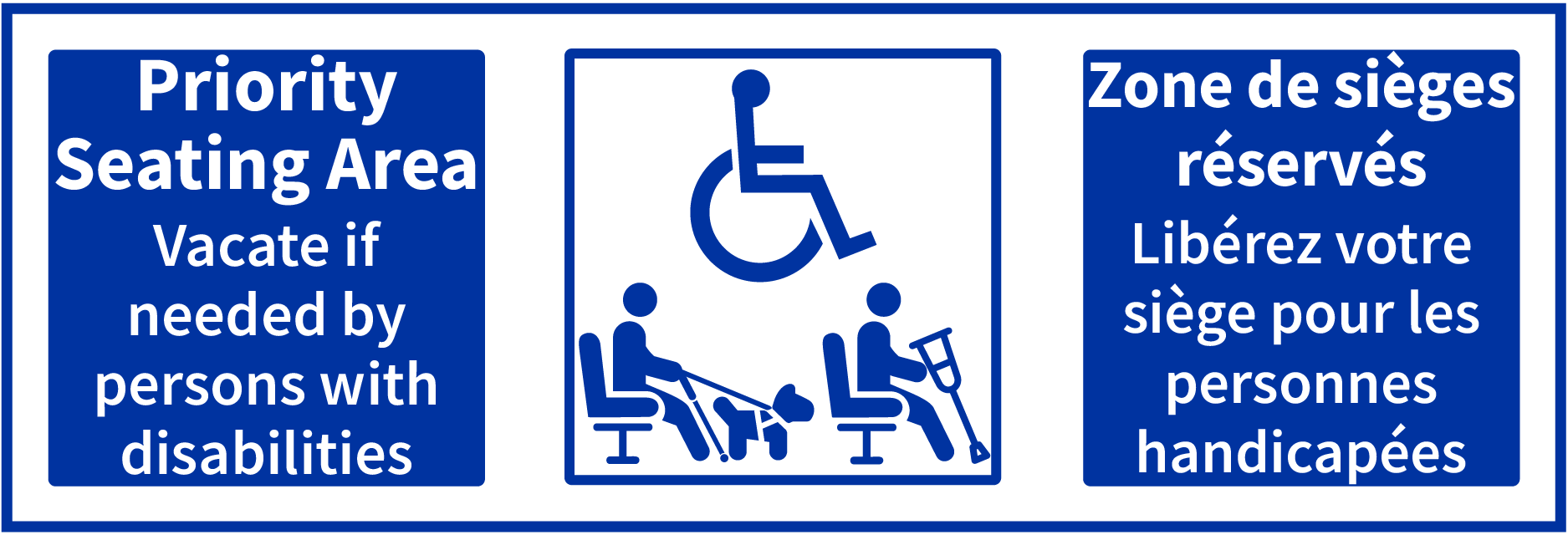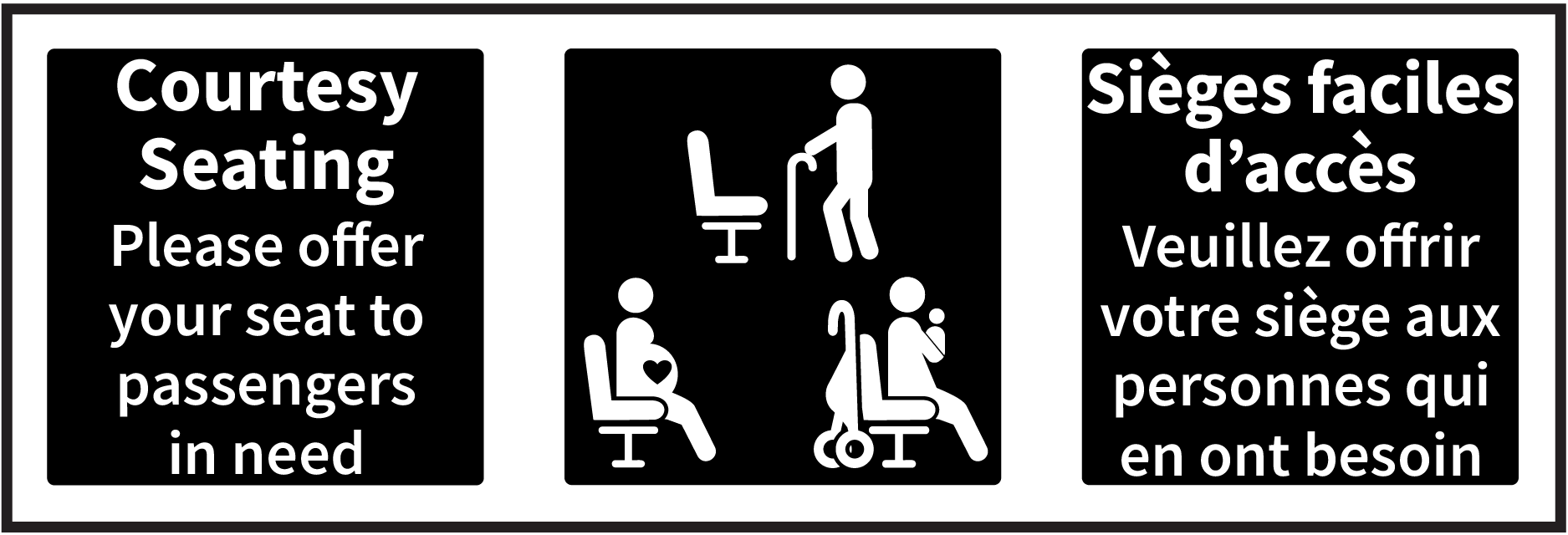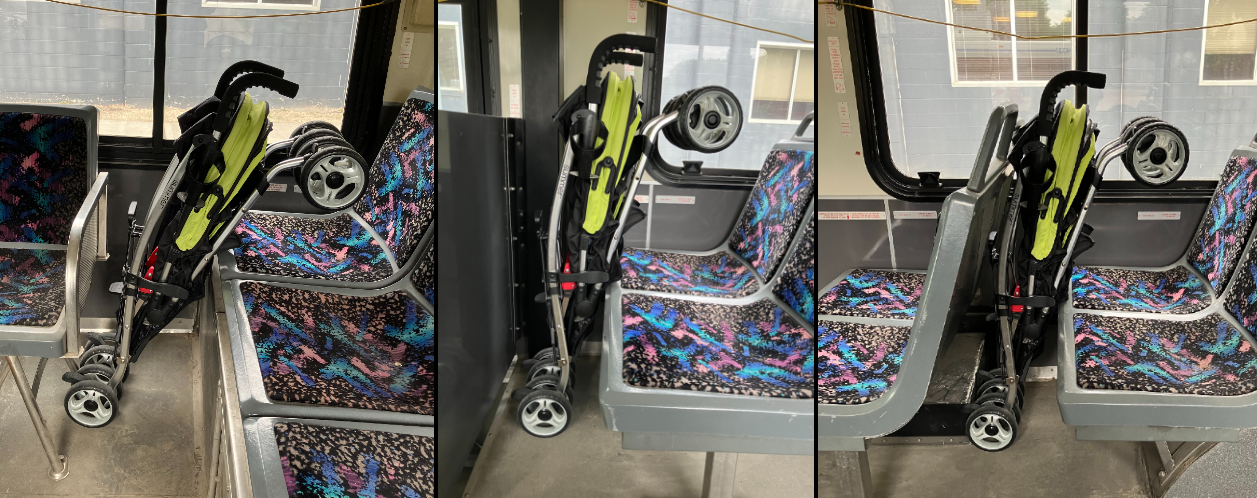Transit Travel Tips
The following travel tips are presented to help you and fellow Transit passengers have a more enjoyable trip.
- Fares
- Request Stop
- Entry and Exit
- Rear Door Operation
- Priority and Courtesy Seating
- Music
- Food and Beverages
- Smoking
- Animals
- Strollers
- Inline Skates
Fares
- Have your fare ready before you board
- If you’re riding for reduced fare, show your photo ID when paying your fare
- If you’re paying with cash, pay the exact fare in coins only; our operators do not carry change
- If you are paying with cash or paper tickets and need a transfer, ask the operator for one when you board
- If you are paying with a peggo card, please hold it against the fare reader until it beeps to ensure the card has been read
- If you are boarding using a paper transfer, please hold it over the QR code reader on the fare box until it beeps
More information is located on our Transit Fares page.
Request Stop After 7 p.m.
For your safety, Winnipeg Transit offers Request Stop. Feel more secure or save a few steps by getting off the bus between regular stops.
- Inform your operator at least one stop ahead of the requested stop.
- Exit by the front door only.
- For safety reasons, the operator may be unable to fulfill your request.
- Request Stop is in effect seven days a week from 7 p.m. until the end of service.
Entry and Exit
- Always use caution when entering and leaving the bus.
- After boarding, step to the back of the bus to let other passengers enter and exit.
- When you are approaching your stop, alert the driver of your intention to exit by pulling the yellow cord that runs along the windows or pressing a stop button.
- Please exit by the rear doors whenever possible using the methods of operation described below.
Rear Door Operation
Once a bus has come to a full stop, a green light above the rear doors turns on to signal that the doors can now be opened. The rear doors are opened by one of three methods, depending on the bus model.
- Touch Strip (narrow, raised yellow strip): Press and hold the touch strip until the door opens
- Sensor (wide, flat yellow strip): Touch the strip, which activates a motion sensor above the door
- Push-bar: Grip and hold the bar until the door opens
The doors will remain open for approximately 3-4 seconds. As a courtesy to following passengers, please keep your hand on the touch strip or the push-bar to have the doors remain open for them.
Priority and Courtesy Seating
Winnipeg Transit’s new Priority and Courtesy Seating Area Policy goes into effect October 5, 2022. All passengers are strongly encouraged to learn more about their role into helping ensure public transit is accessible for all, before this change takes place.
All passengers must work together to help ensure persons with a disability have equitable access to transit as outlined under the Priority and Courtesy Seating Area Policy, and be mindful of others who benefit from a seat near a door. Be aware of these areas on the bus and be prepared to offer your seat to someone in greater need.
Priority Seating Area – Designated for passengers with a disability. Please save these seats for passengers with visible or invisible disabilities.

The priority seating area is located at the front of the bus and is available to passengers with both visible and invisible disabilities. It includes features to accommodate passengers with wheelchairs and scooters, including seats that flip up and securement stations.
- Passengers are asked to save these seats for passengers with disabilities.
- When a passenger with a visible or invisible disability who requires a seat in the priority area boards a bus, passengers who don’t have a disability sitting in that area will be asked to move to another location on the bus. The operator will play an automated message with this request, and if necessary, may also remind other passengers directly to vacate the area. This includes passengers with strollers, who may be required to fold and stow them in order to vacate the area.
- A passenger with a disability is not required to move to make space for another passenger with a disability, however, if a mobility aid securement space is needed, they may be encouraged to move to alternate seating, as wheelchair or scooter users may not be able to access the bus otherwise.
- There is no requirement for any passenger to leave a transit vehicle in order to make room for a passenger with a disability.
- Bus operators are not responsible for enforcement.
Transit passengers using wheelchairs/scooters positioned in the mobility aid securement spaces will ensure that the mobility aids:
- have wheel locks and that they are engaged or power is turned off,
- do not impede the aisles; all aisles must be kept clear at all times,
- proper securement at anchor points using the securement systems located in the priority seating area is recommended .
To ensure they can fit on the ramp, clear the bus entrance, be safely positioned and properly secured, wheelchairs and scooters must be within the following size guidelines: 28 inches in width, 48 inches in length. For safety reasons the maximum weight that can be accommodated on the ramps is 272 kg/600 lbs.
Courtesy Seating Area – For others who benefit from being seated near the door.

The courtesy seating area includes the forward-facing seats located closest to the priority seating area.
Passengers who may use the courtesy seating area include but are not limited to seniors, those who are pregnant, and those travelling with young children.
- Courtesy seating is available on a first-come, first-served basis
- Bus operators will not enforce or intervene on disputes over use of the courtesy seating area.
Transit passengers will ensure that strollers;
- are foldable and can be stored, if necessary,
- do not impede the aisles; all aisles must be kept clear at all times, and
- are able to engage wheel locks where appropriate when on the bus.
Accessible boarding
Passengers are asked to wait at bus stops to allow passengers with disabilities to board the bus before other passengers, and to allow for bus operators to assist upon request .
Accessible Transit
More information about travelling with a wheelchair or scooters and other resources for passengers with disabilities is available on the Accessible Transit page, including information about how to access Travel Training.
Music
- One passenger’s music is another passenger’s noise. Use your headphones.
- Silence is golden when you use your headphones instead of disturbing those around you.
Food and Beverages
Be courteous to others by not eating, drinking or littering on Transit vehicles.
Smoking
By law, smoking and use of e-cigarettes are not permitted on any Winnipeg Transit vehicle or in passenger shelters.
Animals
- Service animals are allowed to accompany their owner on the bus, and are to remain on the floor near the owner or on the owner’s lap
- Pets in small carry-on containers are allowed, provided the owner can safely store it while on-board
Children in Strollers
An overview with tips for passengers travelling with young children is available in PDF format.
Passengers using strollers should be aware that the priority seating area is designated for passengers with a disability, and should be prepared to fold and stow strollers, if necessary, and move to another spot on the bus if priority seating is needed by a passenger with a disability.
The courtesy seating area for others who benefit from a seat close to a door is available in the forward-facing seats located closest to the priority seating area.
Passengers using strollers positioned in the mobility aid securement space (when not required by a passenger with a disability), will ensure that strollers:
- Should be no wider than 28” in order to safely enter and exit the bus
- Should not exceed 48”in length so that it can be maneuvered within the bus and make the turn at the entrance
- Must be foldable and ideally able to fit in the space between two seats when folded (under 12 inches) to avoid obstructing the aisle

Some passengers prefer to plan to travel with their stroller folded and child sitting on their lap or beside them regardless of space available and implement strategies such as:
- Travelling light or with hands free options such as a backpack , fanny pack, etc. whenever possible to make folding the stroller and assisting your child more manageable
- Travelling with a baby/child carrier or small sized stroller rather than an extra large, sport, or multi child stroller
Passengers should make sure that children travelling in strollers when space permits are secured using the restraint system of the stroller.
If the priority seating area is needed by a passenger with a disability, passengers should be prepared to fold strollers and move to another location on the bus, such as the courtesy seating area.
Inline Skates
Passengers wearing inline skates are requested to remove them before boarding for their own safety. If this is not possible, please take a seat near the front of the bus, and when exiting remain seated until the bus has come to a complete stop.



